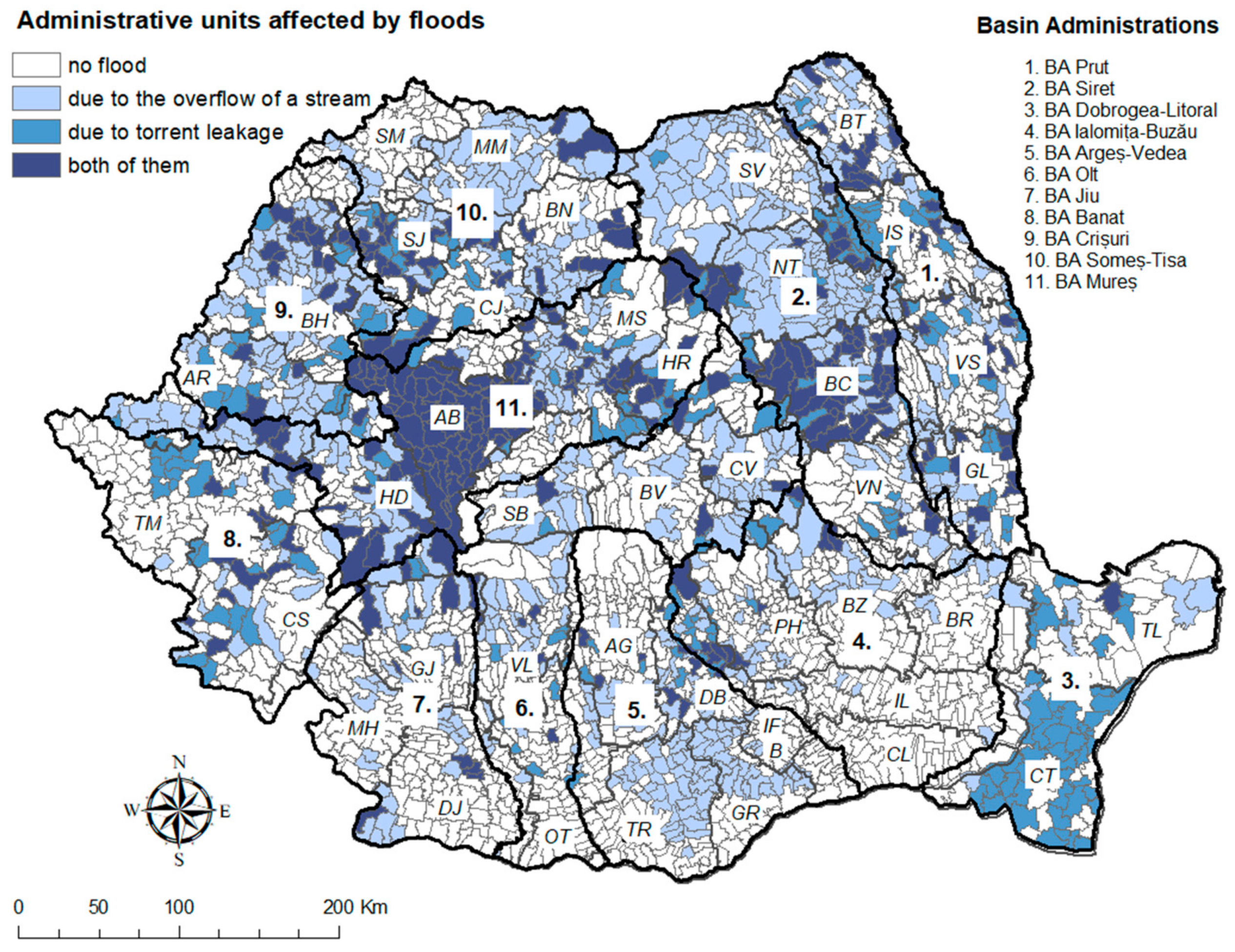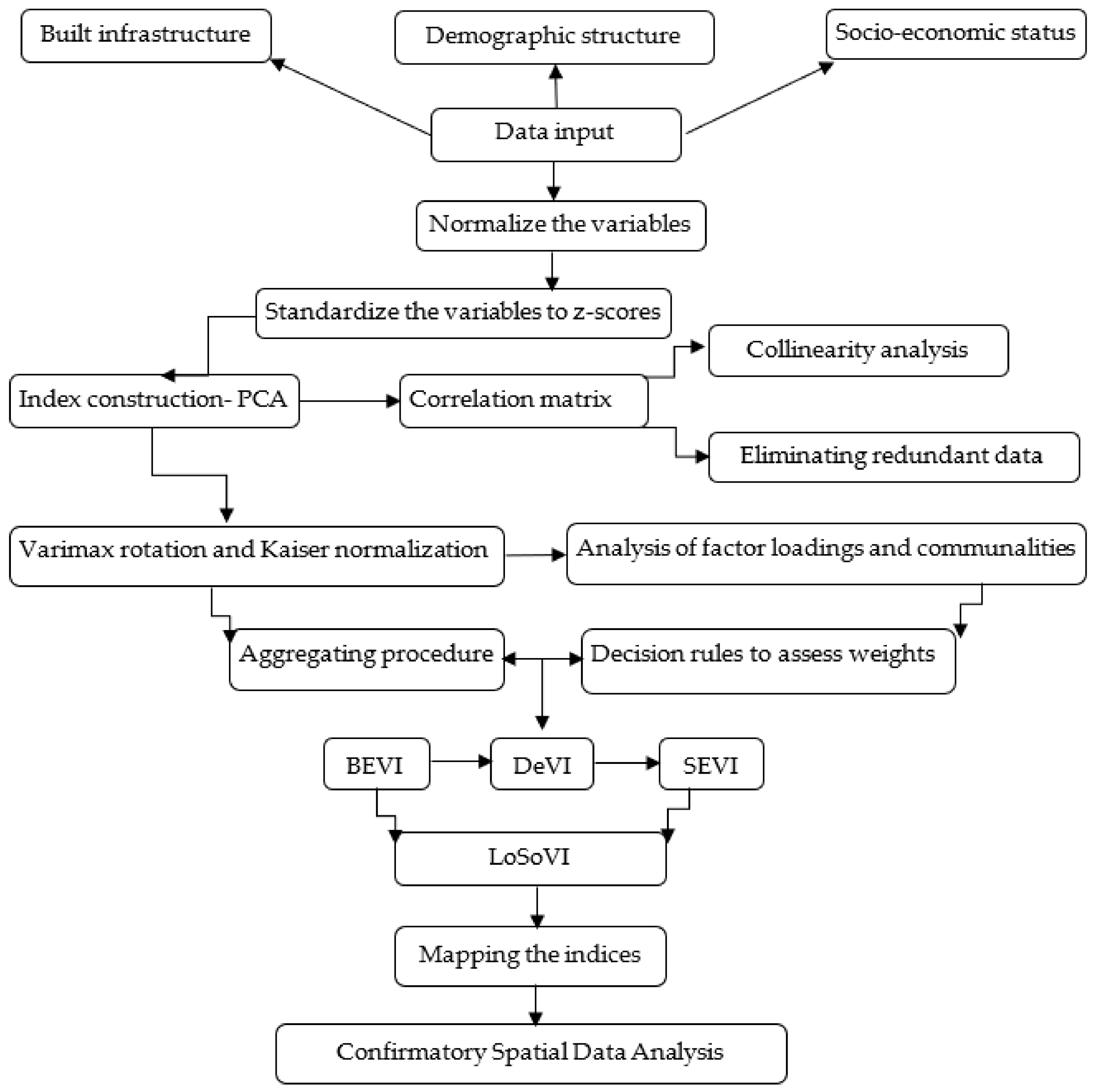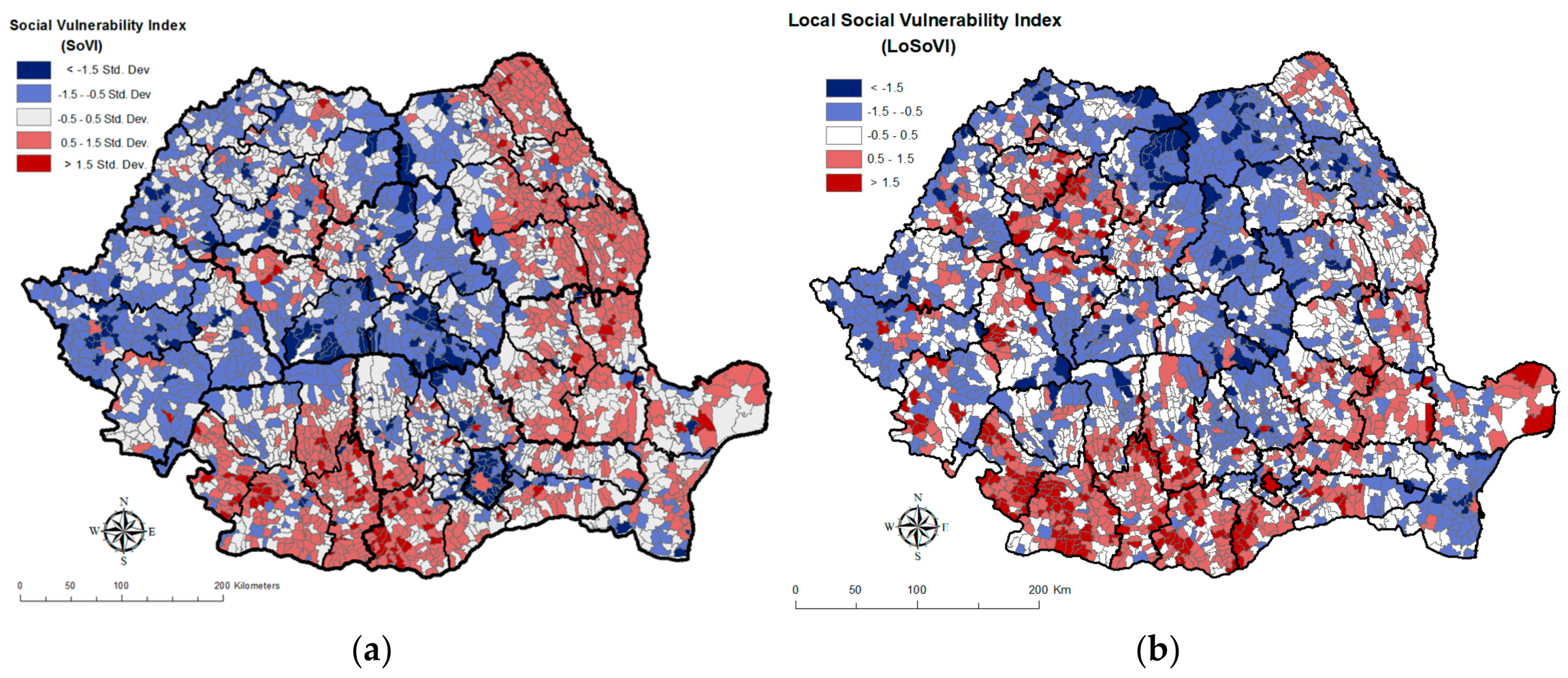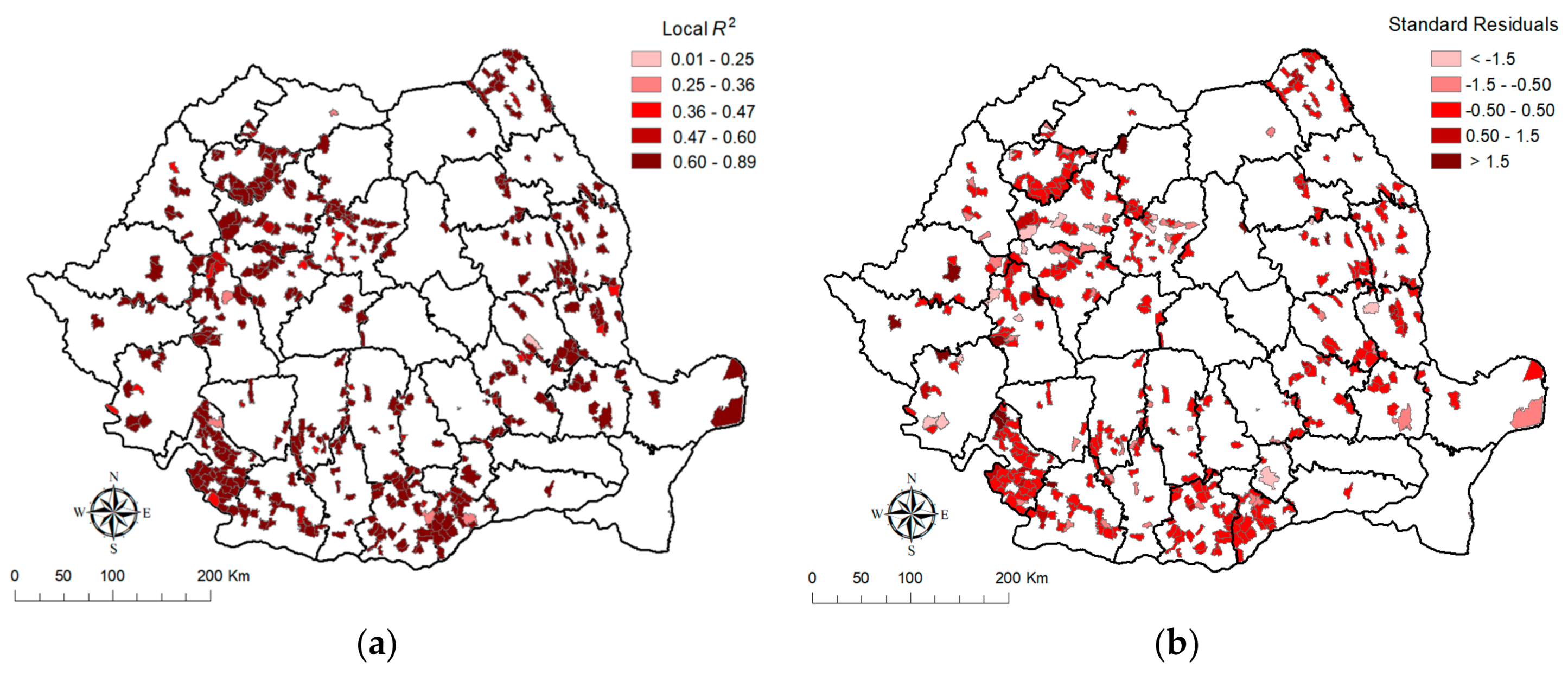Qualitative Assessment of Social Vulnerability to Flood Hazards in Romania
Abstract
:1. Introduction
2. Materials and Methods
2.1. The Study Area
2.2. Selection of Variables
2.3. Methods
3. Results
3.1. Measuring Social Vulnerability
3.2. Geographically Weighted Regression Results
4. Discussion
5. Conclusions
Funding
Conflicts of Interest
Abbreviations
| AB: Alba | AG: Argeș | AR: Arad | B: București | BC: Bacău |
| BH: Bihor | BN: Bistrița-Năsăud | BR: Brăila | BT: Botoșani | BV: Brașov |
| BZ: Buzău | CJ: Cluj | CL: Călărași | CS: Caraș-Severin | CT: Constanța |
| CV: Covasna | DB: Dâmbovița | DJ: Dolj | GJ: Gorj | GL: Galați |
| GR: Giurgiu | HD: Hunedoara | HR: Harghita | IF: Ilfov | IL: Ialomița |
| IS: Iași | MH: Mehedinți | MM: Maramureș | MS: Mureș | NT: Neamț |
| OT: Olt | PH: Prahova | SB: Sibiu | SJ: Sălaj | SM: Satu Mare |
| SV: Suceava | TL: Tulcea | TM: Timiș | TR: Teleorman | VL: Vâlcea |
| VN: Vrancea | VS: Vaslui |
References
- Cutter, S.L.; Boruff, B.J.; Shirley, W.L. Social vulnerability to environmental hazards. Soc. Sci. Quart. 2003, 84, 242–261. [Google Scholar] [CrossRef]
- Rygel, L.; O’sullivan, D.; Yarnal, B. A method for constructing a social vulnerability index: An application to hurricane storm surges in a developed country. Mitig. Adapt. Strateg. Glob. Chang. 2006, 11, 741–764. [Google Scholar] [CrossRef]
- Willis, I.; Fitton, J. A review of multivariate social vulnerability methodologies: A case study of the River Parrett catchment, UK. Nat. Hazards Earth Syst. Sci. 2016, 16, 1387–1399. [Google Scholar] [CrossRef]
- Fekete, A. Validation of social vulnerability index in context to river floods in Germany. Nat. Hazards Earth Syst. Sci. 2009, 9, 393–403. [Google Scholar] [CrossRef]
- Cutter, S.L.; Finch, C. Temporal and spatial changes in social vulnerability to natural hazards. Proc. Natl. Acad. Sci. USA 2008, 105, 2301–2306. [Google Scholar] [CrossRef] [PubMed] [Green Version]
- Tate, E. Social vulnerability indices: A comparative assessment using uncertainty and sensitivity analysis. Nat. Hazards 2012, 63, 325–347. [Google Scholar] [CrossRef]
- Eakin, H.; Luers, A.L. Assessing the vulnerability of social environmental systems. Annu. Rev. Environ. Resour. 2006, 31, 369–394. [Google Scholar] [CrossRef]
- Füssel, H.M.; Klein, R.J.T. Climate change vulnerability assessment: An evolution of conceptual thinking. Clim. Chang. 2006, 75, 301–329. [Google Scholar] [CrossRef]
- Hewitt, K.; Burton, I. The Hazardousness of a Place: A Regional Ecology of Damaging Events, 1st ed.; University of Toronto Press: Toronto, ON, Canada, 1971; ISBN 10 0802030834. [Google Scholar]
- White, G.F. Natural Hazards: Local, National, Global, 1st ed.; Oxford University Press: Oxford, UK, 1976; ISBN 10 0195017579. [Google Scholar]
- Hewitt, K. Interpretation of Calamity from the Viewpoint of Human Ecology, 1st ed.; George Allen & Unwin Ltd.: London, UK, 1983; ISBN 0-04-301160-8. [Google Scholar]
- Cutter, S.L.; Emrich, C.T.; Webb, J.J.; Morath, D.P. Social vulnerability to climate variability hazard: A review of the literature. Final Rep. Oxfam. Am. 2009, 5, 1–44. [Google Scholar]
- Turner, B.L.; Kasperson, R.E.; Matson, P.A.; McCarthy, J.J.; Corell, R.W.; Christensen, L.; Eckley, N.; Kasperson, J.X.; Leurs, A.; Martello, M.L.; et al. Framework for vulnerability analysis in sustainability science. Proc. Natl. Acad. Sci. USA 2003, 100, 8074–8079. [Google Scholar] [CrossRef] [PubMed]
- Kates, R.W. The Interaction of Climate and Society. Available online: http://rwkates.org/pdfs/a1985.01.pdf (accessed on 21 September 2016).
- Cutter, S.L. Vulnerability to environmental hazards. Prog. Hum. Geogr. 1996, 20, 529–539. [Google Scholar] [CrossRef]
- Birkmann, J. Measuring vulnerability to promote disaster-resilient societies and to enhance adaptation: Conceptual frameworks and definitions. In Measuring Vulnerability to Natural Hazard. Towards Disaster Resilience Societies, 2nd ed.; Birkmann, J., Ed.; United Nations University Press: Bonn, Germany, 2013; pp. 9–80. ISBN 10 9280812025. [Google Scholar]
- Holand, I.S.; Lujala, P.; Rød, J.K. Social vulnerability assessment for Norway: A quantitative approach. Nor. Geogr. Tidsskr. 2011, 65, 1–7. [Google Scholar] [CrossRef]
- Chen, W.F.; Cutter, S.L.; Emrich, C.T.; Shi, P. Measuring social vulnerability to natural hazards in the Yangtze River Delta region, China. Int. J. Disaster Risk Reduct. 2013, 4, 169–181. [Google Scholar] [CrossRef] [Green Version]
- Cutter, S.L.; Morath, D.P. The evolution of Social Vulnerability Index (SoVI). In Measuring Vulnerability to Natural Hazards. Towards Disaster Resilience Societies, 2nd ed.; Birkmann, J., Ed.; United Nations University Press: Bonn, Germany, 2013; pp. 304–321. ISBN 10 9280812025. [Google Scholar]
- Rufat, S.; Tate, E.; Burton, C.; Maroof, S.A. Social vulnerability to floods: Review of case studies and implications for measurement. Int. J. Disaster Risk Reduct. 2015, 14, 470–486. [Google Scholar] [CrossRef]
- Mwale, F.D.; Adeloye, A.J.; Beevers, L. Quantifying vulnerability of rural communities to flooding in SSA: A contemporary disaster management perspective applied to the Lower Shire Valley, Malawi. Int. J. Disaster Risk Reduct. 2015, 12, 172–187. [Google Scholar] [CrossRef]
- Frigerio, I.; Amicis, M. Mapping social vulnerability to natural hazards in Italy: A suitable tool for risk mitigation strategies. Environ. Sci. Poicy 2016, 63, 187–196. [Google Scholar] [CrossRef]
- Armaș, I.; Toma-Dănilă, D.; Ionescu, R.; Gavriș, A. Vulnerability to earthquake hazard: Bucharest case study, Romania. Int. J. Disaster Risk Sci. 2017, 8, 182–195. [Google Scholar] [CrossRef]
- Bănică, A.; Roșu, L.; Muntele, I.; Grozavu, A. Towards urban resilience: A multi-criteria analysis of seismic vulnerability in Iași city (Romania). Sustainability 2017, 9, 270. [Google Scholar] [CrossRef]
- Li, K.; Li, G.S. Vulnerability assessment of storm surges in the coastal area of Guangdong Province. Nat. Hazards Earth Syst. Sci. 2011, 11, 2003–2010. [Google Scholar] [CrossRef] [Green Version]
- Kuhlicke, C.; Scolobig, A.; Tapsell, S.; Steinführer, A.; De Marchi, B. Contextualizing social vulnerability: Findings from case studies across Europe. Nat. Hazards 2011, 58, 789–810. [Google Scholar] [CrossRef]
- Ashley, S.T.; Ashley, W.S. Flood fatalities in the United States. J. Appl. Meteorol. Climatol. 2008, 47, 805–818. [Google Scholar] [CrossRef]
- Doocy, S.; Daniels, A.; Murray, S.; Kirsch, T.D. The human impact of floods: A historical review of events 1980–2009 and systematic literature review. PloS Curr. 2013. [Google Scholar] [CrossRef] [PubMed]
- Lowe, D.; Ebi, K.L.; Forsberg, B. Factors increasing vulnerability to health effects before, during and after floods. Int. J. Environ. Res. Public Health 2013, 10, 7015–7067. [Google Scholar] [CrossRef] [PubMed]
- Ajibade, I.; McBean, G.; Bezner-Kerr, R. Urban flooding in Lagos, Nigeria: Patterns of vulnerability and resilience among women. Glob. Environ. Chang. 2013, 23, 1714–1725. [Google Scholar] [CrossRef]
- Stângă, I.C.; Grozavu, A. Quantifying human vulnerability in rural areas: case study of Tutova Hills (Eastern Romania). Nat. Hazards Earth Syst. Sci. 2012, 12, 1987–2001. [Google Scholar] [CrossRef] [Green Version]
- Armaș, I.; Gavriș, A. Social vulnerability assessment using spatial multi-criteria analysis (SEVI model) and the Social Vulnerability Index (SoVI model)—A case study for Bucharest, Romania. Nat. Hazards Earth Syst. Sci. 2013, 13, 1481–1499. [Google Scholar] [CrossRef]
- Bănică, A.; Muntele, I. Urban vulnerability and resilience in post-communist Romania (Comparative case studies of Iasi and Bacau cities and Metropolitan areas). Carpath. J. Earth Env. 2015, 4, 159–171. [Google Scholar]
- Constantin, V.; Ștefănescu, L.; Kantor, C.M. Vulnerability assessment methodology: A tool for policy makers in drafting a sustainable development strategy of rural mining settlements in the Apuseni Mountains, Romania. Environ. Sci. Policy 2015, 52, 129–139. [Google Scholar] [CrossRef]
- Török, I. Assessment of social vulnerability to natural hazards in Romania. Carpath. J. Earth Env. 2017, 12, 549–562. [Google Scholar]
- Marinescu, M.; Stanciu, C.; Marinescu, G. Four important natural hazards from Romania. Romanian J. Earth Sci. 2010, 84, 113–115. [Google Scholar]
- Queste, L.; Lauwe, P. User needs: Why we need indicators. In Measuring Vulnerability to Natural Hazards. Towards Disaster Resilience Societies, 2nd ed.; Birkmann, J., Ed.; United Nations University Press: Bonn, Germany, 2013; pp. 103–115. [Google Scholar]
- National Institute of Statistics, Romania‒INS. Available online: www.insse.ro (accessed on 18 July 2018).
- Nardo, M.; Saisana, M.; Saltelii, A.; Tarantola, S.; Hoffman, A.; Giovanni, E. Handbook of Constructing Composite Indicators. Methodology and User Guide; OECD Statistics Working Papers; OECD: Paris, France, 2005. [Google Scholar]
- Guillard, G.C.; Cutter, S.L.; Emrich, C.T.; Zezere, J.L. Application of Social Vulnerability Index (SoVI) and delineation of natural risk zones in Greater Lisbon, Portugal. J. Risk Res. 2015, 18, 651–674. [Google Scholar] [CrossRef]
- Hummell, L.; Cutter, S.L.; Emrich, C.T. Social vulnerability to natural hazards in Brazil. Int. J. Disaster Risk Sci. 2016, 7, 111–122. [Google Scholar] [CrossRef]
- Mazumdar, J.; Kumar, S. Socioeconomic and infrastructural vulnerability indices for cyclones in the eastern coastal states of India. Nat Hazards 2016, 82, 1621–1643. [Google Scholar] [CrossRef]
- Huynh, L.T.M.; Stringer, L.C. Multi-scale assessment of social vulnerability to climate change. An empirical study in coastal Vietnam. Clim. Risk Manag. 2018, 20, 165–180. [Google Scholar] [CrossRef]
- Kazmierczak, A.; Cavan, G. Surface water flooding risk to urban communities: Analysis of vulnerability, hazard and exposure. Landsc. Urban Plan. 2011, 103, 185–197. [Google Scholar] [CrossRef]
- Hutchesion, G.; Sofroniou, N. The Multivariate Social Scientist: Introductory Statistics Using Generalized Linear Models, 1st ed; SAGE Publications: London, UK, 1999; ISBN 10 0761952012. [Google Scholar]
- Wood, N.J.; Burton, C.G.; Cutter, S.L. Community variations in social vulnerability to Cascadia-related tsunamis in the US Pacific Northwest. Nat. Hazards 2010, 52, 369–389. [Google Scholar] [CrossRef]
- Bjarnadottir, S.; Li, Y.; Stewart, M.G. Social vulnerability index for coastal communities at risk to hurricane hazard and changing climate. Nat. Hazards 2011, 59, 1055–1075. [Google Scholar] [CrossRef]
- Solangaarachchi, D.; Griffin, A.; Doherty, M.D. Social vulnerability in the context of bushfire risk at the urban-bush interface in Sydney: A case study of the Blue Mountains and Ku-ring-gai local council areas. Nat. Hazards 2012, 64, 1873–1898. [Google Scholar] [CrossRef]
- Nkeki, F.D.; Osirike, A.B. Gis-based local spatial statistical model of cholera occurrence: using geographically weighted regression. J. Geogr. Inf. Syst. 2013, 5, 531–542. [Google Scholar] [CrossRef]
- Akaike, H. Akaike, H. A new look at the statistical model identification. In Selected Papers of Hirotogu Akaike, 1st ed.; Parzen, E., Tanate, K., Kitagawa, G., Eds.; Springer: New York, NY, USA, 1974; pp. 215–223. ISBN 978-1-4612-7248-9. [Google Scholar]
- Shoff, C.; Yang, T.C. Spatially varying predictors of teenage birth rates among counties in the United States. Demogr. Res. 2012, 27, 377–418. [Google Scholar] [CrossRef] [PubMed]
- Fotheringham, A.S.; Brunsdon, C.; Charlton, M. Geographically Weighted Regression: The Analysis of Spatially Varying Relationship, 1st ed.; Wiley: New York, NY, USA, 2002; ISBN 0471496162. [Google Scholar]
- Nakaya, T.; Charlton, M.; Yao, J.; Fotheringham, A.S. GWR4.09 User Manual: Windows Application For Geographically Weighted Regression Modelling. Available online: https://raw.githubusercontent.com/gwrtools/gwr4/master/GWR4manual_409.pdf (accessed on 14 September 2017).
- Huang, J.; Su, F.; Zhang, P. Measuring social vulnerability to natural hazards in Beijing-Tianjin-Hebei Region, China. Chin. Geogr. Sci. 2015, 25, 472–485. [Google Scholar] [CrossRef]
- O’brien, R.M. A caution regarding rules of thumb for variance inflation factors. Qual. Quant. 2007, 41, 673–690. [Google Scholar] [CrossRef]
- Maghura, E.; Manyena, B.; Collins, A.E. An approach for measuring social vulnerability in context: The case of flood hazards in Mazurabani district, Zimbabwe. Geoforum 2017, 86, 103–117. [Google Scholar]
- IPCC. Summary for policymakers. Available online: http://www.ipcc.ch/report/ar5/wg2/ (accessed on 18 September 2018).
- MMAP. Strategia Nationala de management al riscului la inundatii pe termen mediu si lung. Available online: http://www.mmediu.ro/app/webroot/uploads/files/2012-01-10_risc_inundatii_hg846din2010aprobaresnmri.pdf (accessed on 17 September 2018).
- Radulescu, D.; Bogdan, I.M.; Dumitrache, R.; Barbu, C.E. Flood risk management objectives and Romanian cataloque of potential measures for flood prevention, protection and mitigation. Available online: https://www.paidromania.ro/statistici-anuale (accessed on 16 September 2018).
- PAID Romania. Available online: https://paidromania.ro/en/description (accessed on 31 August 2018).
- Tapsell, S.; McCarthy, S.; Faulkner, H.; Alexander, M.; Social Vulnerability and Natural Hazards. CapHaz-Net WP4 Report. Available online: http://caphaz-net.org/outcomes-results/CapHaz- Net_WP4_Social-Vulnerability.pdf. (accessed on 17 June 2015).




| Variables | Mean | SD | Min | Max |
|---|---|---|---|---|
| Share of households with access to piped water | 39.58 | 25.59 | 0.06 | 99.07 |
| Share of households with access to a sewage network | 37.34 | 24.90 | 0.06 | 99.00 |
| Share of households with a central heating system | 11.72 | 16.82 | 0.06 | 96.36 |
| Share of households with a kitchen area | 73.76 | 17.28 | 1.38 | 99.67 |
| Share of households with a fixed bath | 33.14 | 23.54 | 0.06 | 99.84 |
| Average number of people per household | 16.50 | 4.64 | 2.65 | 92.40 |
| Number of housing units per square kilometre | 2.47 | 0.54 | 0.22 | 8.37 |
| Number of houses constructed from wood | 12.53 | 16.28 | 0.00 | 94.60 |
| Number of houses with a reinforced structure | 0.57 | 1.06 | 0.00 | 12.22 |
| Population density | 103.47 | 303.92 | 1.35 | 8144.87 |
| Share of population aged 65 years and above | 25.16 | 7.59 | 2.12 | 77.01 |
| Demographic dependency ratio | 1694.35 | 865.85 | 123.25 | 8676.47 |
| Share of widows within female population | 11.34 | 3.55 | 1.52 | 45.56 |
| Share of the Roma population | 1.48 | 4.46 | 0.00 | 81.11 |
| Number of births per 1000 persons | 9.11 | 4.29 | 0.00 | 67.43 |
| Share of the population under 5 years old | 16.29 | 4.12 | 1.30 | 59.22 |
| Net international migration rate | 1.11 | 9.03 | −74.70 | 74.20 |
| Share of women from the total population | 46.99 | 5.13 | 9.79 | 94.33 |
| Percent employed in services | 26.90 | 14.09 | 5.28 | 88.25 |
| Share of population with university education | 5.06 | 4.37 | 0.00 | 44.61 |
| Access to major public road networks | 1.92 | 1.06 | 0.00 | 5.00 |
| Access to railway transportation | 1.33 | 1.83 | 0.00 | 5.00 |
| Illiteracy rate | 2.12 | 2.10 | 0.03 | 30.46 |
| Per capita income | 568.85 | 537.81 | 10.57 | 9740.21 |
| Entrepreneurial activity rate | 24.71 | 4.27 | 0.00 | 47.20 |
| Employment rate | 61.6 | 23.62 | 1.27 | 78.2 |
| Tax collection rate at the local budget level | 0.36 | 0.26 | 0.08 | 5.00 |
| References | Hazard Type | Studied Area | Spatial Units | Input Variables | Component Weighting | High Vulnerability |
|---|---|---|---|---|---|---|
| Wood et al., 2010 [46] | Tsunami | Pacific Northwest, USA | Census block | 29 | Variance weighting | >1 SD above mean |
| Bjarnadottir et al., 2011 [47] | Hurricane | Miami, FL | Municipality | 16 | Expert-assigned | None |
| Solangaarachhi et al., 2012 [48] | Bushfire | South-eastern Australia | Census Collection District | 26 | Variance | >1 SD above mean |
| Mwale et al., 2015 [21] | Flooding | Lower Shire Walley, Malawi | Area Development | 44 | Variance weighting | >0.8 |
| Frigerio et al., 2016 [22] | Earthquake | Italy | Municipalities | 15 | Variance weighting | >1 |
| Armaș et al., 2017 [23] | Earthquake | Bucharest, Romania | Census tracts | 18 | Expert assigned | None |
| Bănică et al., 2017 [24] | Earthquake | Iași, Romania | Buildings | 15 | Analytical Hierarchy Process | 9 |
| Component | Percent Variance Explained | Dominant Variables | Component Loading | Sign | |
|---|---|---|---|---|---|
| Built Vulnerability Index | Housing facilities | 43.977 | Share of households with access to piped water | −0.963 | − |
| Share of households with access to sewage networks | −0.964 | ||||
| Share of households with a central heating system | −0.803 | ||||
| Share of households with a kitchen area | −0.676 | ||||
| Share of households with a fixed bath | −0.966 | ||||
| Quality of living | 16.133 | Average number of people per household | 0.859 | + | |
| Number of housing units per square kilometre | −0.846 | ||||
| Quality of housing | 11.607 | Number of houses constructed from wood | 0.654 | + | |
| Number of houses with a reinforced structure | −0.586 | ||||
| Population density | 0.691 | ||||
| Cumulative variance explained | 71.717 | ||||
| Kaiser-Mayer-Olkin Measure of Sampling Adequacy 0.815 Bartlett’s Test of Sphericity 0.000 | Extraction Method: Principal Component Analysis. Rotation Method: Varimax with Kaiser Normalization. Rotation converged in 5 iterations. | ||||
| Demographic Vulnerability Index | Family structure | 40.211 | Share of population aged 65 years and above | 0.916 | + |
| Demographic dependency ratio | 0.825 | ||||
| Share of widows within the female population | 0.913 | ||||
| Demographic vitality and ethnicity | 18.870 | Share of Roma population | 0.633 | + | |
| Number of births per 1000 persons | 0.794 | ||||
| Share of the population under 5 years old | 0.746 | ||||
| Gender and mobility | 14.211 | Net international migration rate | 0.888 | + | |
| Share of women from the total population | 0.601 | ||||
| Cumulative variance explained | 73.292 | ||||
| Kaiser-Mayer-Olkin Measure of Sampling Adequacy 0.637 Bartlett’s Test of Sphericity 0.000 | Extraction Method: Principal Component Analysis. Rotation Method: Varimax with Kaiser Normalization. Rotation converged in 5 iterations. | ||||
| Socio-Economic Vulnerability Index | Education and accessibility | 56.566 | Percent employed in services | −0.780 | − |
| Share of population with a university education | −0.610 | ||||
| Access to major public road networks | −0.831 | ||||
| Access to railway transportation | −0.546 | ||||
| Illiteracy rate | 0.909 | ||||
| Poverty and employment | 14.438 | Per capita income | −0.871 | − | |
| Entrepreneurial activity rate | −0.700 | ||||
| Employment rate | −0.698 | ||||
| Tax collection rate at local budget level | −0.901 | ||||
| Cumulative variance explained | 71.004 | ||||
| Kaiser-Mayer-Olkin Measure of Sampling Adequacy 0.827 Bartlett’s Test of Sphericity 0.000 | Extraction Method: Principal Component Analysis. Rotation Method: Varimax with Kaiser Normalization. Rotation converged in 3 iterations. | ||||
| Standard Deviation | Level of Vulnerability |
|---|---|
| >1.5σ | Very high |
| 0.5 to 1.5 | High |
| −0.5 to 0.5 | Moderate |
| −1.5 to −0.5 | Low |
| <−1.5 | Very low |
| LoSoVI Scores | Pearson Correlation | Sig. (2-Tailed) | VIF | N |
|---|---|---|---|---|
| Housing facilities | −0.340 ** | 0.000 | 3.005 | 408 |
| Quality of housing | 0.283 ** | 0.000 | 1.348 | 408 |
| Family structure | −0.146 ** | 0.003 | 1.544 | 408 |
| Education and accessibility | 0.312 ** | 0.000 | 2.817 | 408 |
| Income and employment | 0.265 ** | 0.000 | 2.119 | 408 |
| Fitness Parameter | OLS | GWR |
|---|---|---|
| AICc | 9139.28 | 8816.42 |
| Coefficient determination R2 | 0.444 | 0.834 |
| Adjusted R2 | 0.436 | 0.787 |
© 2018 by the author. Licensee MDPI, Basel, Switzerland. This article is an open access article distributed under the terms and conditions of the Creative Commons Attribution (CC BY) license (http://creativecommons.org/licenses/by/4.0/).
Share and Cite
Török, I. Qualitative Assessment of Social Vulnerability to Flood Hazards in Romania. Sustainability 2018, 10, 3780. https://doi.org/10.3390/su10103780
Török I. Qualitative Assessment of Social Vulnerability to Flood Hazards in Romania. Sustainability. 2018; 10(10):3780. https://doi.org/10.3390/su10103780
Chicago/Turabian StyleTörök, Ibolya. 2018. "Qualitative Assessment of Social Vulnerability to Flood Hazards in Romania" Sustainability 10, no. 10: 3780. https://doi.org/10.3390/su10103780
APA StyleTörök, I. (2018). Qualitative Assessment of Social Vulnerability to Flood Hazards in Romania. Sustainability, 10(10), 3780. https://doi.org/10.3390/su10103780





